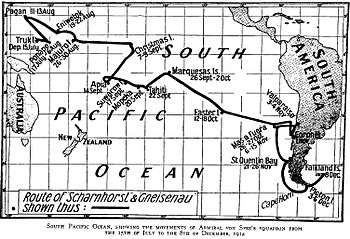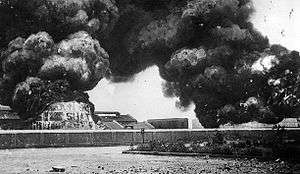Asian and Pacific theatre of World War I
| Asian and Pacific theatre of World War I | |||||||
|---|---|---|---|---|---|---|---|
| Part of World War I | |||||||
 The Siege of Tsingtao. | |||||||
| |||||||
| Belligerents | |||||||
|
|
| ||||||
| a Surrender of Hermann Detzner's unit. | |||||||
The Asian and Pacific theatre of World War I consisted of various naval battles and the Allied conquest of German colonial possessions in the Pacific Ocean and China. The most significant military action was the careful and well-executed Siege of Tsingtao in what is now China, but smaller actions were also fought at Bita Paka and Toma in German New Guinea.
All other German and Austrian possessions in Asia and the Pacific fell without bloodshed. Naval warfare was common; all of the colonial powers had naval squadrons stationed in the Indian or Pacific Oceans. These fleets operated by supporting the invasions of German-held territories and by destroying the East Asia Squadron.
Allied offensives in the Pacific
One of the first land offensives in the Pacific theatre was the Occupation of German Samoa in August 29 and 30 1914 by New Zealand forces. The campaign to take Samoa ended without bloodshed after over 1,000 New Zealanders landed on the German colony, supported by an Australian and French naval squadron.
Australian forces attacked German New Guinea in September 1914: 500 Australians encountered 300 Germans and native policemen at the Battle of Bita Paka; the Allies won the day and the Germans retreated to Toma. A company of Australians and a British warship besieged the Germans and their colonial subjects, ending with a German surrender.[1]
After the fall of Toma, only minor German forces were left in New Guinea and these generally capitulated once met by Australian forces. In December 1914, one German officer near Angorum attempted to resist the occupation with thirty native police but his force deserted him after they fired on an Australian scouting party and he was subsequently captured.[2]
By 1915, the only uncapitulated German force was a small expedition under the command of Hermann Detzner which managed to elude Australian patrols and hold out in the interior of the island until the end of the war, for which he became a figure of some renown.
German Micronesia, the Marianas, the Carolines and the Marshall Islands also fell to Allied forces during the war.
German naval actions
Retreat of the German East Asia Squadron
In the Pacific

When war was declared on Germany in 1914, the German East Asia Squadron withdrew from its base at Tsingtao and attempted to make its way east across the Pacific and back to Germany. After concentrating the majority of its force at Pagan Island, the fleet raided several Allied targets as it made its way across the Pacific.
Detached cruisers raided the cable station at Fanning and then rejoined with the squadron. Later the German forces would attack Papeete where Admiral Maximilian von Spee with his two armoured cruisers sank a French gunboat and a freighter before bombarding Papeete's shore batteries.
Chile and the Falklands
The next engagement was fought off Chile at the Battle of Coronel on November 1, 1914, Admiral Spee won the battle by defeating a British squadron which was sent to destroy him. His two armored and three light cruisers sank two Royal Navy armored cruisers and forced a British light cruiser and auxiliary cruiser to flee. Over 1,500 British sailors (all hands aboard both cruisers) were killed while only three Germans were wounded. The victory did not last long as the German fleet was soon defeated in Atlantic waters at the Battle of the Falklands in December 1914. Spee himself went down with his own flagship SMS Scharnhorst.
The only German vessels to escape the Falklands engagement was the light cruiser Dresden and the auxiliary Seydlitz. Seydlitz fled into the Atlantic before being interned by neutral Argentina, while Dresden turned about and steamed back into the Pacific. The Dresden then attempted to act as a commerce raider, without much success, until March 1915 when its engines began to break down.
Without means of getting repairs, the German light cruiser sailed into neutral Chilean waters at the island of Mas a Tierra where it was cornered by British naval forces. After a short battle in which four of her crew were killed, the Dresden was forced to scuttle and her crew was interned by Chilean authorities.
SMS Emden in the Indian Ocean

SMS Emden was left behind by Admiral Graf Maximilian von Spee when he began his retreat across the Pacific. The ship won the Battle of Penang, in which the Germans sank a Russian cruiser and a French destroyer. Emden also harried merchant vessels of the Allies and destroyed over thirty of them. She went on and bombarded Madras, India, causing damage to British oil tanks and sinking an Allied merchant ship. The attack caused widespread panic in the city and thousands of people fled from the coast, fearing that the Germans may have begun an invasion of India as a whole.
After a very successful career as a merchant raider, Emden was engaged by HMAS Sydney at the Battle of Cocos, where the German vessel was destroyed. A group of sailors under the command of Hellmuth von Mücke managed to escape towards the Arabian peninsula which was then part of the Ottoman Empire, an ally of the German Empire during World War I.
The cruise of SMS Seeadler
The SMS Seeadler, an auxiliary cruiser windjammer and merchant raider, commanded by Felix von Luckner managed successful attacks on Allied shipping in both the Atlantic and Pacific Oceans. During her career she captured sixteen vessels and sank most of them.
In August 1917 SMS Seeadler was wrecked at the island of Mopelia in French Polynesia so the Germans established a small colony on the island which housed them and several Allied prisoners, most of whom were American. Eventually when starvation proved to be an urgent concern, Luckner and his crew left the prisoners on the uninhabited island and set sail in a lifeboat for Fiji. There, on September 5, Luckner captured a French schooner named Lutece and renamed her Fortuna.
After that they headed for Easter Island and again their ship was wrecked when it grounded on a reef. Subsequently the Germans were interned by the Chileans on October 5, 1917 which ended the journey. During the entire cruise only one man perished, due to an accident.
The scuttling of SMS Cormoran at Guam
.jpg)
The United States was involved in at least one hostile encounter with Germans in the Pacific during World War I. On August 7, 1917, the SMS Cormoran was scuttled in Apra Harbor, Guam to prevent her capture by the auxiliary cruiser USS Supply. The Americans fired their first shots of the war at the Germans as they attempted to sink their ship. Ultimately the Germans succeeded in scuttling the Cormoran with a loss of nine men dead.
In China
The Siege of Tsingtao

Tsingtao was the most significant German base in the area. It was defended by 3,650 German troops supported by 1,000 Chinese colonial troops and Austro-Hungarian soldiers and sailors occupying a well-designed fort. Supporting the defenders were a small number of vessels from the Imperial German Navy and the Austro-Hungarian Navy.
The Japanese sent nearly their entire fleet to the area, including six battleships and 23,000 soldiers. The British sent two military units to the battle from their garrison at Tientsin, numbering 1,500, and the Chinese who were unoccupied by the Germans sent over a few thousand troops on the side of the allies.
The bombardment of the fort started on October 31. An assault was made by the Imperial Japanese Army on the night of November 6. The garrison surrendered the next day. Casualties of the battle were 703 on the German side and some 3,600 POW; casualties on the Allied side were 2,066. One Allied protected cruiser was also sunk by a German torpedo boat and when defeat was certain, the Germans and Austro-Hungarians scuttled their squadron.
Manchu Restoration
The German government was accused of being behind Zhang Xun's monarchist coup in China to prevent Duan Qirui's pro-war faction from supporting the Allies. After the coup failed in July 1917, Duan used the incident as a pretext for declaring war on Germany.
The German and Austro-Hungarian concessions in Tientsin and Hankow were occupied and their nationals detained. An even more serious plot was Germany's funding of the Constitutional Protection Movement, which geographically split China into two rival governments for eleven years.
Gallery
-

The German fleet off Chile in November 1914 after the Battle of Coronel.
-

Madras oil tanks on fire after being bombarded by SMS Emden.
-
.jpg)
Australian troops after digging up a German land mine along Bita Paka Road during the New Guinea Campaign.
-
The German auxiliary cruiser SMS Seeadler.
See also
Notes
References
- Falls, Cyril (1960). The Great War, pgs. 98–99.
- Keegan, John (1998). World War One, pgs. 205–206.